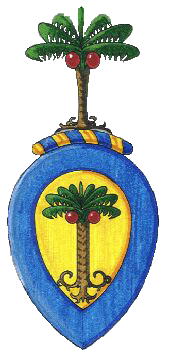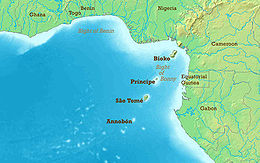São Tomé Island, at 854 km2 (330 sq mi), is the largest island of São Tomé and Príncipe and is home in May 2018 to about 193,380 or 96% of the nation's population. The island is divided into six districts. It is located 2 km (1¼ miles) north of the Equator.
Native name:
Ilha de São Tomé | |
|---|---|

Emblem of São Tome
| |
 | |
| Geography | |
| Location | Gulf of Guinea |
| Coordinates | 0°13′N 6°37′E / 0.22°N 6.61°E / 0.22; 6.61 |
| Archipelago | Cameroon line |
| Area | 859 km2 (332 sq mi) |
| Length | 48 km (29.8 mi) |
| Width | 32 km (19.9 mi) |
| Highest elevation | 2,024 m (6640 ft) |
| Highest point | Pico de São Tomé |
| Administration | |
| Districts | 6 |
| Largest settlement | São Tomé (pop. 71,868) |
| Demographics | |
| Population | 193,380 (2018) |
| Pop. density | 225/km2 (583/sq mi) |
| Ethnic groups | Mestiços, angolares (descendants of Angolan slaves), forros (descendants of freed slaves), serviçais (contract laborers from Angola, Mozambique, and Cape Verde), tongas (children of serviçais born on the islands), Europeans (primarily Portuguese) |

São Tomé Island is about 48 kilometres (30 miles) long (north-south) by 32 kilometres (20 miles) wide (east-west). It rises to 2,024 metres (6,640 feet) at Pico de São Tomé and includes the capital city, São Tomé, on the northeast coast. The nearest city on mainland Africa is the port city of Port GentilinGabon located 240 kilometres (150 miles) to the east.
The island is surrounded by a number of small islands, including Ilhéu das Rolas, Ilhéu das Cabras and Ilhéu Gabado.
The main language is Portuguese, but there are many speakers of Forro and Angolar (Ngola), two Portuguese-based creole languages. The name "São Tomé" is Portuguese for Saint Thomas.
The entire island of São Tomé is a massive shield volcano that rises from the floor of the Atlantic Ocean, over 3,000 m (10,000 ft) below sea level. It formed along the Cameroon line, a line of volcanoes extending from Cameroon southwest into the Atlantic Ocean. Most of the lava erupted on São Tomé over the last million years has been basalt. The youngest dated rock on the island is about 100,000 years old, but numerous more recent cinder cones are found on the southeast side of the island.
The higher slopes of the island are forested and form part of the Parque Natural Obô de São Tomé, but agriculture is important near the north and east coasts. The chief exports are cocoa, coffee, copra, and palm products, while there is also a fishing industry.
Large reserves of oil are in the ocean between Nigeria and São Tomé. The discovery has been lamented by some as endangering the nation's political stability and natural environment. In response to these concerns the government of São Tomé and Príncipe has drawn up legislation in an attempt to ensure the efficient and equitable use of oil revenues over time.
The island has a total of 63 regular bird species, plus an additional 36 vagrant and unconfirmed species. Of these, 19 are endemic and 3 near endemic; in addition, the local subspeciesofolive ibis (Bostrychia olivacea bocagei) and maroon pigeon (Columba thomensis) are endemic and considered critically endangered. Six species are considered vulnerable, and two critically endangered (São Tomé fiscal and São Tomé grosbeak).[1][2]
São Tomé is divided into the following six districts (seat within brackets):
Villages on the island include: